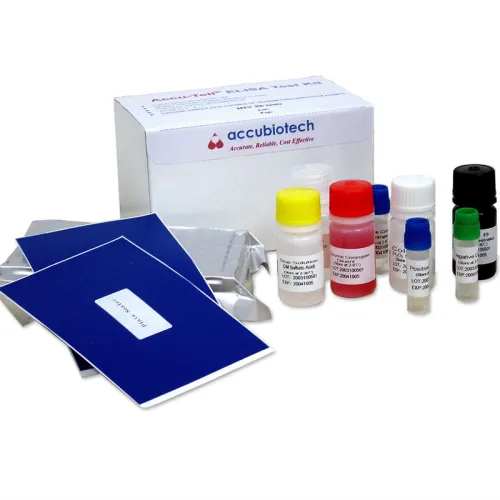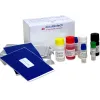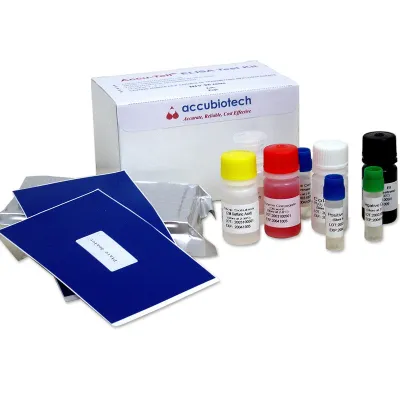Accu-Tell® HBeAg Elisa Test Kit
Product Description
CATALOG
| Product Name | Specimen | Catalog No. | Quantity per box |
| HBeAg Elisa Test | Serum/Plasma | ABT-EIA-F2 | 96T |
SUMMARY OF THE MAJOR COMPONENTS OF THE KIT:
Use this summary only as a reference and always follow the comprehensive method sheet when performing the assay. Note: the components of individual kits are not lot- interchangeable.
| 1. Microwell plate | one |
| 2. Negative Control | 1x1ml |
| 3. Positive Control | 1x1ml |
| 4. HRP-Conjugate | 1x6.5ml |
| 5. Wash Buffer | 1x30ml |
| 6. Chromogen Solution A | 1x7ml |
| 7. Chromogen Solution B | 1x7ml |
| 8. Stop Solution | 1x7ml |
SUMMARY OF THE ASSAY PROCEDURE:
Use this summary only as a reference and always follow the detailed method sheet when performing the assay.
| Add Samples / Controls | 50ml |
| Add HPR-Conjugate | 50ml |
| Incubate | 60minutes |
| Wash | 5times |
| Coloring | 50ml A + 50ml B |
| Incubate | 15minutes |
| Stop the reaction | 50ml stop solution |
| Read the absorbance | 450nm or 450/630 nm |
INTENDED USE
ACCU-TELL® HBeAg ELISA is an enzyme-linked immunosorbent assay (ELISA) for qualitative detection of hepatitis B virus e antigen (HBeAg) in human serum or plasma. It is intended for use in clinical laboratories for diagnosis and management of patients related to infection with hepatitis B virus.
PERFORMANCE CHARACTERISTICS
This kit was standardized against Reference Standards from the Reference Laboratory for Immunology Product under the Ministry of Health, China. Analytical Endpoint Sensitivity: 0.2NCU (National Current Unit, MOH, China).
Clinical Specificity: This clinical specificity of this kit has been determinate by a panel of samples obtained from 4360 healthy blood donors and 150 undiagnosed hospitalized patients. The repeatedly reactive samples and samples confirmed positive with the reference test were not included in the calculation of specificity.
Clinical Sensitivity: The clinical sensitivity of HBeAg ELISA was calculated by a panel of samples obtained from 813 hepatitis B patients with well-characterized clinical history based upon reference assays for detection of HBsAg, HBeAg, anti-HBs, anti-HBe, and anti-HBc. Licensed HBeAg ELISA was used as a confirmatory assay. The evaluation results are given below.
| Specificity | Number of Sample | - | + | ConfirmedPositive | Specificity | False Positive |
| Donors | 4360 | 4346 | 14 | 9 | 99.86% | 5 |
| Patients | 150 | 132 | 18 | 18 | 100% | 0 |
| Total | 4510 | 4478 | 32 | 27 | 99.93% | 5 |
| Sensitivity | Number of Sample | - | + | Confirmedpositive | Sensitivity | False Negatives |
| Acute | 378 | 172 | 206 | 206 | 100% | 0 |
| Chronic | 347 | 162 | 185 | 185 | 100% | 0 |
| Recovery | 88 | 63 | 25 | 25 | 100% | 0 |
| Total | 813 | 397 | 416 | 416 | 100% | 0 |
Analytical Specificity:
No cross reactivity was observed with samples from patients infected with HAV, HCV, HIV, CMV, and TP.
No interference from rheumatoid factors up to 2000U/ml and no high dose hook effect up to HBeAg concentrations of 150000NCU were observed.
The assay performance characteristics are unaffected from elevated concentrations of bilirubin, hemoglobin, and triolein.
Frozen specimens have been tested to check for interferences due to collection and storage.
LIMITATIONS
1. Positive results must be confirmed with another available method and interpreted in conjunction with the patient clinical information.
2. Antigens may be undetectable during the early stage of the disease. In very rare cases some HBV mutants or subtypes can remain undetectable. Therefore, negative results obtained with HBeAg ELISA are only indication that the sample does not contain detectable level of HBeAg.
3. If, after retesting of the initially reactive samples, the assay results are negative, these samples should be considered as non-repeatable (false positive) and interpreted as negative. As with many very sensitive ELISA assays, false positive results can occur due to the several reasons, most of which are related but not limited to inadequate washing step. For more information regarding ELISA Troubleshooting, please refer to “ELISAs and Troubleshooting Guide”, or contact technical support for further assistance.
4. The most common assay mistakes are: using kits beyond the expiry date, bad washing procedures, contaminated reagents, incorrect assay procedure steps, insufficient aspiration during washing, failure to add specimens or reagents, improper operation with the laboratory equipment, timing errors, the use of highly hemolyzed specimens or specimens containing fibrin, incompletely clotted serum specimens.
5. The prevalence of the marker will affect the assay’s predictive values.
6. This kit is intended ONLY for testing of individual serum or plasma samples. Do not use it for testing of cadaver samples, saliva, urine or other body fluids, or pooled (mixed) blood.
7. This kit is a qualitative assay and the results cannot be used to measure antigen concentration.
Note: The above information is for reference use only. Please refer to the product insert provided with the products before use.
View More




